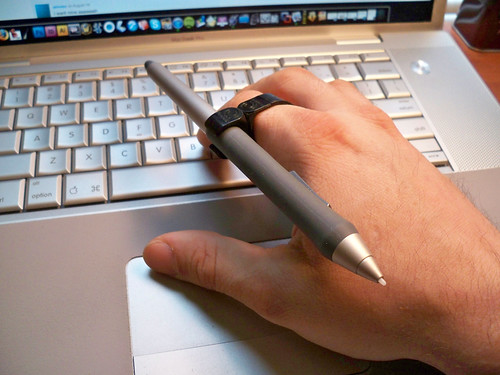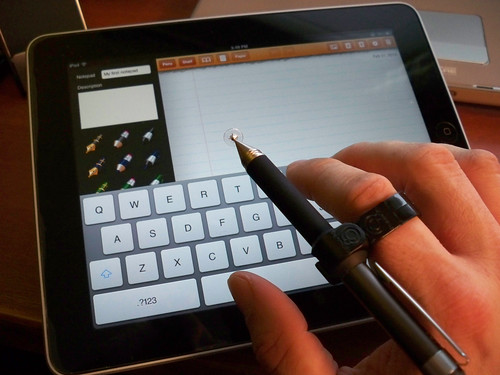(This is a guest post by Brian Draghi. You can follow Brian on Twitter @Sketchscape)
The PenMoto was introduced as a project on Kickstarter early last year and it was something I was looking forward to on the first day of funding. Initially, PenMoto was made and geared for digital artists and photographers who constantly switched back and forth from the keyboard and Wacom tablet and stylus. PenMoto then expanded from just using a stylus to being able to hold a wide variety of pens. Despite the setback on production and delivery, PenMoto is a solid option for artists and pen addicts everywhere who constantly change between a computer, tablet and hand written notes. This is a great tool to save some time working during your day as well as being a cool little gadget to play with.
PenMoto is a self-sizing magnetic ring with a coupler that quickly retrieves and stores a pen on the back of your hand for the transition from using a Wacom tablet, to writing with a pen and typing using a keyboard. The ring is used on the finger and the coupler is attached to a stylus or pen which can be accessed with a simple flick of the index finger. You can use your tablets touchscreen with a stylus and switch to using your fingers without having to put down your stylus every time. There are two different versions of PenMoto, one made out of plastic nylon 6 material with the inner part of the ring made up of soft rubber called santoprene. The other version of PenMoto is a sized ring made from die-cast lightweight aluminum alloy.
Package contents
PenMoto arrives is a small box that unfolds to contain all three different self-sizing rings along with the three different sized couplers to match. Also included on a cardstock insert are a total of 8 different adaptive rubber strips that adjust to a wide variety of pens and other tablet styli. The smallest pen I can use with PenMoto is the Pilot Hi-Tec-C Slim Knock pen and the largest is a Sharpie marker. The packaging also contains diagrams on the inside back showing the proper use and wear of the ring and coupler.
The package also directs you to the PenMoto website with video tutorials showing how to rotate your pen properly. All Kickstarter backers received an extra bonus set of small and large magnets as well as the adhesive Teflon dots for each magnet type. These adhesive dots provide extra security to keep the magnets in place in both the ring and coupler. The replacement dots and the extra magnets help facilitate the spinning action of a stylus or pen.
Thoughts
PenMoto works much like it was described in the Kickstarter project and despite some minor issues, it functions much like I thought it would. It gives me the ability to quickly switch from my Wacom stylus to my keyboard by flipping it around to the back of my hand. This saves me some time instead of having to constantly pick up and put down my pen to use my keyboard. Before, I had to always look around for my pen since I never put it down in the same place twice. Now, It rests right on the back of my hand immediately ready for me to use when I need it.
It is ideal for my iPad when I'm using my Adonit Jot stylus. I can easily switch from typing on my tablet to using my stylus in a couple of seconds. This is also perfect for switching between most pens and the keyboard especially since I constantly take notes or create sketches while sitting at my computer.
There are a few problems I do have with PenMoto. First off, it feels like a prototype. Instead of a high gloss black finish, it appears like dull cheap plastic. For the self-sizing ring, you can see the part line running down the middle of the it. While the self-sizing feature allows for adjustment, it also feels fragile since the rings feature a break on the outside and inside to allow for finger expansion. The rubber adaptive strips for pens are starting to fray very slightly due to placing them in pockets and I'm concerned about their durability in the long run. The rubber is thick enough that it shouldn't be too much of an issue but it's still hard to tell at this point. I can't really compare it to the aluminum sized ring since I didn't receive that version but I can definitely see the benefits of a sized ring with a great finish.
The adhesive Teflon dots that cover the small and large magnets to keep them more secure and aid with spinning on the ring and coupler have started to slowly come off after about a few weeks of use. The extra dots that came with the project help with this but it's an issue that comes into play. The self-sizing ring has some issues with loose fitting after a while, but a simple solution was provided by PenMoto's creator. It can be made into a sized ring by using a drop of super glue on the inside and the outside of the ring to keep it from expanding.
There was a small learning curve to adjust to flipping the pen with my hand but the tutorials on the website help with this. Another recommendation to help with spinning is when I applied a small amount of ChapStick on the magnets to make the pen rotate on the ring faster. This helped to learn how to flip my pen or stylus since I was having some difficulty. I really liked how everything is packaged together and everything was accessible and present. The tabs that hold the adaptive strips are a little fragile after you take them out and it's a little tricky getting them back on. It would be hard to keep everything contained in the box because it's just not durable enough to use effectively for storage.
Overall
Despite the minor problems with the PenMoto, this is a solid project that works as described to switch quickly between pen, stylus and the keyboard. I was able to pledge only 15 dollars on Kickstarter to receive my PenMoto, with the 8 adaptive strips, extra adhesive dots and one set of extra magnets. With the value in what I received, it would take a major disaster for me to be dissatisfied here. The PenMoto helps to save me time switching between my various devices and it's quite fun to use.
The creator of PenMoto, Kelvin Geis, is already open to the idea of developing a second generation PenMoto to improve some of the flaws and minor issues of the current model. It has taken 4 years for Kelvin to develop PenMoto and it's great to see projects like this come to life all because of Kickstarter. I'd like to thank Kelvin for all his hard work in bringing this into reality. I look forward to any future versions of PenMoto he plans to develop. Please check out PenMoto.com if anyone is interested in pre-ordering one of their very own after all the Kickstarter pledges are fulfilled.
See Brian's full PenMoto photo set on Flickr.







